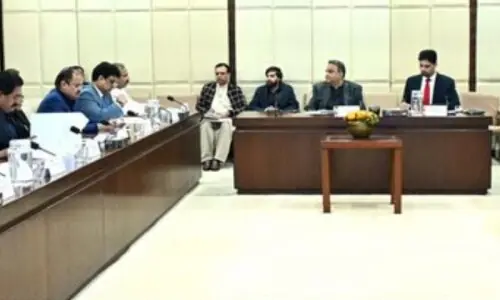Citizens got to see the inside of the presidency in person for the first time on Saturday, after the building was opened to the public.
Formally known as Aiwan-i-Sadr, the building sits at the top of the hill on Constitution Avenue, between Parliament House and Pakistan Secretariat’s cabinet block. The presidency was the centre of national politics until 2008, before which presidents were empowered to dissolve the National Assembly and dismiss elected governments under Article 58-2(b) of the Constitution.
Construction of the building began in 1970 and took 11 years to complete, finally ending during the tenure of Gen Ziaul Haq. Haq inaugurated the building, but never lived in it, choosing instead to stay in the Army House on Jhelum Road in Rawalpindi.
Before the presidency was build, presidents like Gen Ayub Khan, Gen Yahya Khan and Fazal Elahi Chaudhry lived in Prince Palace, on The Mall, which now houses Fatima Jinnah Women University.
Ghulam Ishaq Khan was the first president to actually reside in the President House, followed by Farooq Leghari, Mohammad Rafique Tarar, Asif Ali Zardari, Mamnoon Hussain and the incumbent Dr Arif Alvi.
Gen Pervez Musharraf also chose to live in Army House during his tenure as president, but by this time the Army House on Jhelum Road had moved to the old Prime Minister House. A new Prime Minister House was built in Islamabad during Benazir Bhutto’s first tenure.

Aiwan-i-Sadr’s gardens have been constructed on the pattern of old Mughal gardens, with various species of trees and flowers, as well as a zoo and fountains. The gardens were one of the main attractions for visitors on Saturday, as were the halls where prime ministers, chief justices of Pakistan and presidents take oath.
The building also features a swimming pool and private chambers for the president, the president’s family and guests. The back gardens and two halls – Jinnah Hall and Liaquat Hall – were opened to the public, while Johar Hall and Nishtar Hall were not.
The mini zoo was established in 2008, on orders from then president Asif Ali Zardari, who is said to be fond of animals. Initially, it housed deer, monkeys, zebras, neelgai and pheasants and other birds. Today the zoo is home to deer, chinkara, urial, pheasants and grey parrots and pigeons.
There is also a stable, as the president uses a horse-drawn carriage at national events. The stable is home to more than a hundred horses.
The presidency was opened to the public by the PTI government, but state buildings around the world are open to visitors. Buckingham Palace in London is open to guests between August and September, while the Rashtarpati Bhawan – the Indian presidential house – is open to the public four days a week.
Visitors on Saturday did express some complaints regarding the lack of information on the building while speaking to Dawn, but were pleased to see the inside of a building.

“I just came to see how the rulers live in big houses,” said Mohammad Riaz from Rawalpindi.
Abbotabad resident Mohammad Najeeb said he had come to see the Aiwan-i-Sadr after he saw the palace in the United Kingdom.
Muniza Anwar said she had long wished to see the inside of the building. She said she often sees it while driving to work on Constitution Avenue, and had been curious to see what it was like inside after occasionally seeing it on TV.
Published in Dawn, December 9th, 2018



































